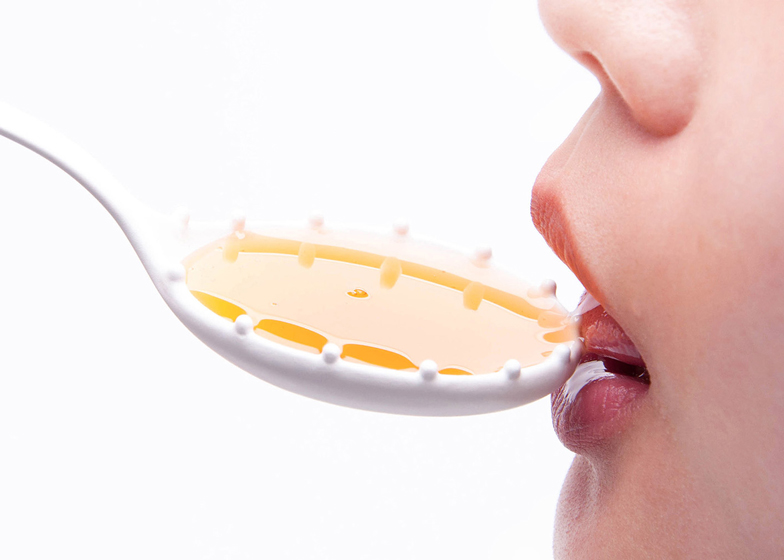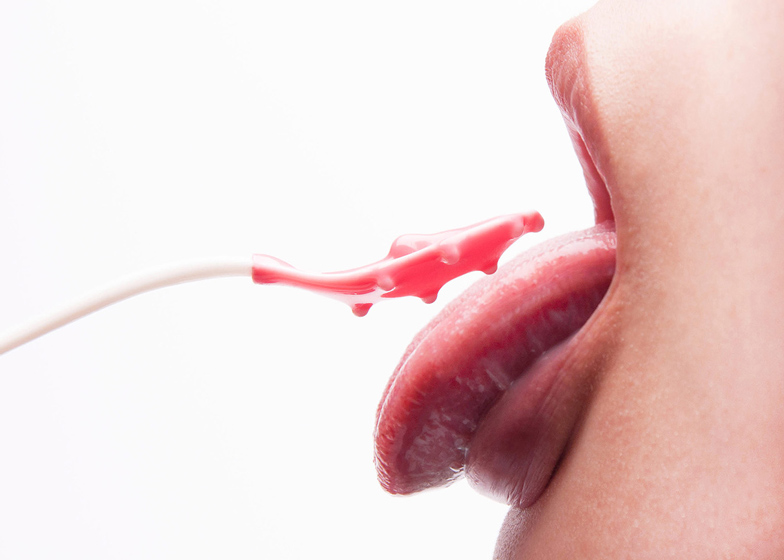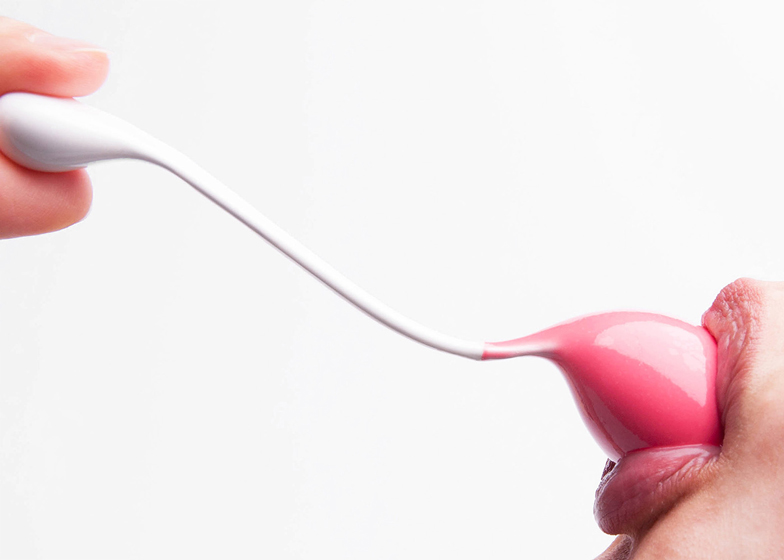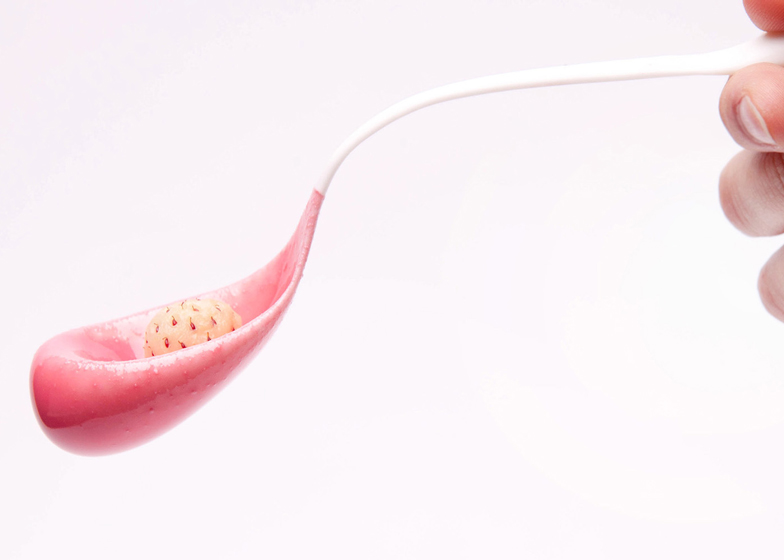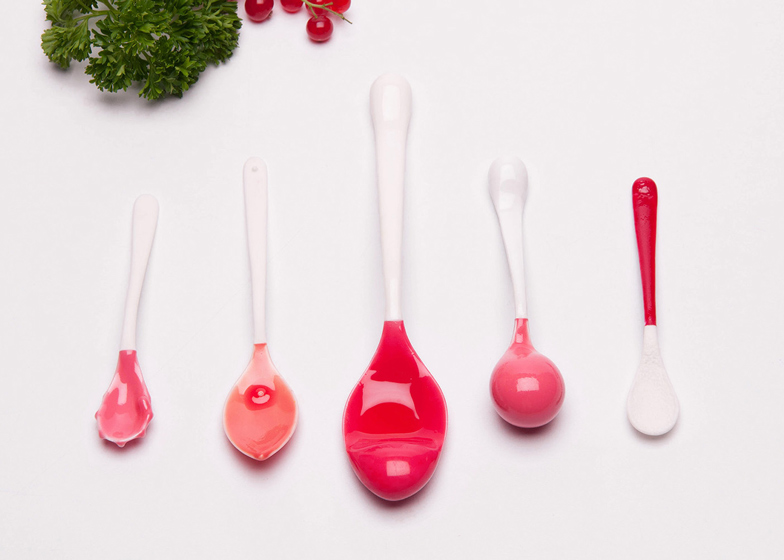Can the shape, texture and colour of cutlery change the way food tastes? Design Academy Eindhoven graduate Jinhyun Jeon created this set of knobbly, bulbous and serrated cutlery to stimulate diners' full range of senses at the table (+ slideshow).
Jinhyun Jeon, a graduate of the Design Academy Eindhoven in the Netherlands, made Tableware as Sensorial Stimuli as part of her MA thesis about the relationship between food and the senses.
The project was inspired by the phenomenon of synesthesia, a neurological condition in which stimuli like taste, colour and hearing are affected and triggered by each other. People with synesthesia often report seeing a certain colour when they hear a particular word, for example.
To find out whether this "sensory cross-wiring" could be encouraged and used to enhance taste, Jeon created cutlery based on five sensory elements: colour, tactility, temperature, volume and weight, and form.
The ceramic pieces shown here explore the effects of colour, with various coloured glazes defining the tips of each implement.
Warm colours such as red and orange are supposed to increase appetite, says Jeon, and are most effective when used sparingly.
Other pieces are made from stainless steel, silver or plastic, and the various textures and shapes are intended to stimulate the sense of touch inside the mouth.
Above: photograph by Femke Riierman
The plastic pieces resemble glass, which creates a jarring sensation for the user when the item's appearance is incongruous with its feel. "We tend to believe our sight and touch would be the same, but this is not the whole story," says Jeon.
"The tools I created make us focus on each bite, feel the enriched textures or enhanced chewing sounds between bites," she told Dezeen. "If we can stretch the borders of what tableware can do, the eating experience can be enriched."
Other strange sets of cutlery we've featured on Dezeen include a set of knives, forks and spoons that look like workshop tools and plastic cutlery that clips together to form a small table sculpture.
See our top ten projects from this year's Design Academy Eindhoven show here.
See all our stories about cutlery »
See all our stories about tableware »
Photographs are by Jinhyun Jeon except where stated.
Here's some more information from the designer:
Tableware as Sensorial Stimuli – 'Enhanced Tasty Formulas'
Cutlery design focuses on getting food in bite‐sized morsels from the plate to the mouth, but it could do so much more. The project aims to reveal just how much more, stretching the limits of what tableware can do.
Focusing on ways of making eating a much richer experience, a series of dozens of different designs has been created, inspired by the phenomenon of synesthesia. This is a neurological condition where stimulus to one sense can affect one or more of the other senses.
An everyday event, 'taste' is created as a combination of more than five senses. Tasty formulas with the five elements – temperature, colour, texture, volume/weight and form – are applied to design proposal.
By exploring synesthesia, if we can stretch the borders of what tableware can do, the eating experience can be enriched in multi-cross‐wiring ways. The tableware we use for eating should not just be a tool for placing food in our mouth, but it should become an extension of our body, challenging our senses even in the moment when the food is still on its way to being consumed.
Each of these designs has been created to stimulate or train different senses, allowing more than just our tastebuds to be engaged in the act and enjoyment of eating as sensorial stimuli, therefore it would lead the way of mindful eating which guides to rediscovering a healthy and joyful relationship with food.
Temperature: The temperature influences certain changes to the taste. Sugar starts to taste sweeter at body temperature. Salty tastes become stronger when the temperature drops. A sour taste will always be a sour taste when the temperature rises or drops. Bitterness decreases as the temperature rises above the body temperature.
Tactility: According to Dr. Linda Bartoshuk of Yale University School of Medicine, it is generally known that the tongue map is incorrect. Sweet, sour, salty, and bitter are perceived anywhere there are taste buds. When a strong sweet taste and strong salty taste are mixed, it creates a completely new taste. When salty and sour tastes are mixed, both the tastes soften. If the salty and sour tastes are mixed well, a sweet taste can be created. If the sweet taste is stronger than salty taste, the sweet taste becomes stronger. The different types of sensitive tactile spoons could not only stimulate our tongue, but also lips and the palate. The exact effects depend on the level of individual sensibility of our own tongue map.
Colours: Colours can increase appetite when using warm colours, such as red, orange, and yellow. Comparing how sweet tastes between red and yellow with the same level of sugar, the sweetness of the red (crimson, scarlet) coloured food is stronger than yellow. Orange stimulates the appetite, because orange has been found to increase oxygen supply to the brain, and stimulates mental activity. Yellow increases metabolism so it is a good choice for dishes or tablecloths. However, if the food and the table are arranged with warm colours, it could decrease the appetite. The warm colours are most effective when used in small amounts to create highlights.
Volume and weight: The volume of the hollow part of the spoon influences and enhances the auditory sense of the sound scraping against glassware, as well as our taste/appetite. A spoon that is 40g in weight can give us the sense of stability. However, if you decrease the weight to 10g, then we are able to feel the weight of food, making us more aware of the amounts of food that we are eating.
Form: Adding new elements to the general archetype of a spoon aims to give the sense of comfort in hand, but also makes using it more intimate. Changing the thickness of the handle can create more awareness when eating. Small amounts of food can become heavy, or big amounts of food increase awareness about the consuming moment.
How can we slow down the moment of one bite and taste enhanced sweetness, while nevertheless consuming less sugar? 'Tasty formulas', which have been created by Jinhyun Jeon, would help us to understand interesting ways of how we consume our food with the tasty cutlery for enhanced temperature/tactility/ colour/volume/weight/form, interpreted in synesthetic ways:
SWEET × 36.5°C = SWEET +++
SALTY ×
SOUR × 36.5°C = SOUR × 100°C
BITTER × > 36.5°C = BITTER -‐
SWEET + (0.5% × SALT) = SWEET ++
SALT ÷ SOUR = SALTY/SOUR -‐
SALTY × SOUR = SWEET +
10% × (5R 4/14+5YR 4/14+5Y 4/14) = 2.0
90% × (5R 4/14+5YR 4/14+5Y 4/14) = 0.1
20% × R > 20% × Y
5cm3 × SOUND/ SIGHT = 10g × TOUCH
1mm × TOUCH > 10mm × TOUCH (y=f(x)) × TOUCH = Y

